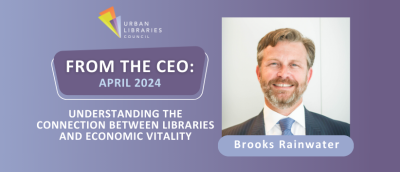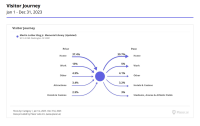Understanding the Connection Between Libraries and Economic Vitality

Written by Brooks Rainwater, President and CEO, Urban Libraries Council
In the nearly two years since I joined ULC as President and CEO, a big question that remains present in our work to strengthen and advance the essential role of public libraries is: How are libraries recovering from the COVID-19 pandemic?
ULC tackled this question in our inaugural Library Insights Survey, which found that digital lending soared between 2019 and 2022, and in-person visits and programming are rebounding after reaching record lows during the pandemic. We look forward to opening the survey again this spring to gather more information about members’ library services and operations to track how our field is making progress.
We also published a report last year — Libraries as Spaces for Innovation and Productivity — that explores the importance of congregation in a post-pandemic world. It looked at the role of libraries as reliable structures, attractions and prime choices for visits even as we experience a great upheaval of spaces in which people prioritize spending time. Libraries with a downtown location historically contribute a significant amount of steady foot traffic and daytime population and serve as trip attractions based on the number of daily, weekly and monthly users tracked by libraries.
To support the primary recommendation from that report — the promotion of libraries as hubs for congregation, trip attractors and investors of post-pandemic economic activity — ULC sought out additional data to advance this thesis. Today, we are sharing some of our preliminary research around the connection between public libraries and economic vitality in a new case study about what is happening at the DC Public Library, and its impact on Downtown DC foot traffic.
Research Case Study: DC Public Library
Like most major cities in the U.S., Washington DC’s downtown is seeing reduced economic activity since the pandemic. This is owed to a handful of factors, including a level of remote work more than twice the national average, according to the DC Policy Center. Despite these trends, the Martin Luther King, Jr. Memorial Library (MLK Library) is attracting people to the downtown area.
Using location analytics data from Placer.ai, ULC analyzed the trip attraction performance of visitors to the MLK Library in 2023 and then to other locations downtown. While a large percentage of visits to the MLK Library in 2023 were by individuals coming from a home or residence to the library and eventually back there, many visitors went to another downtown location or elsewhere in the DC area after visiting the library.
You can read the full case study and explore accompanying infographics at this link.
ULC’s emerging research indicates that the library should play a significant role in downtown activation plans. This case study offers just one example of the potential for libraries to serve as major factors in attracting steady daytime population and foot traffic in urban cores and downtowns. By coupling this kind of location analysis with information provided by member libraries, such as through the annual insights survey or ULC Business Value Calculator, we intend to capture a stronger understanding of how libraries contribute to the economic vitality of their cities. I am excited that we will deepen this research throughout the year ahead and look forward to sharing more about what we learn.

